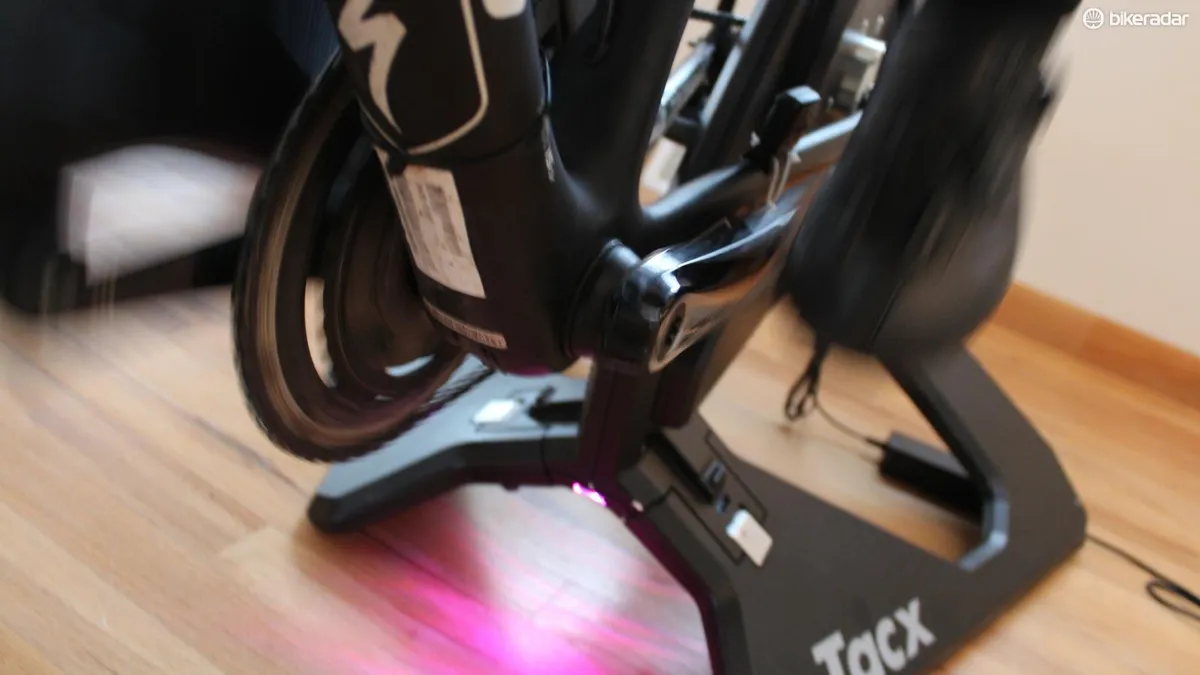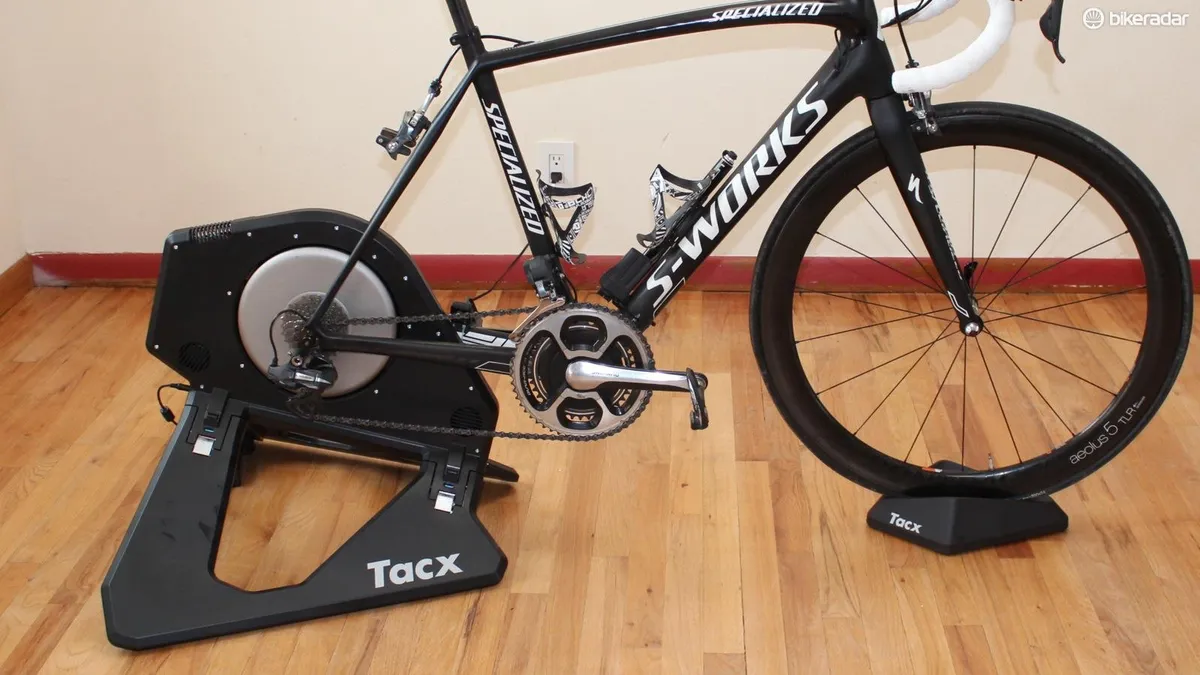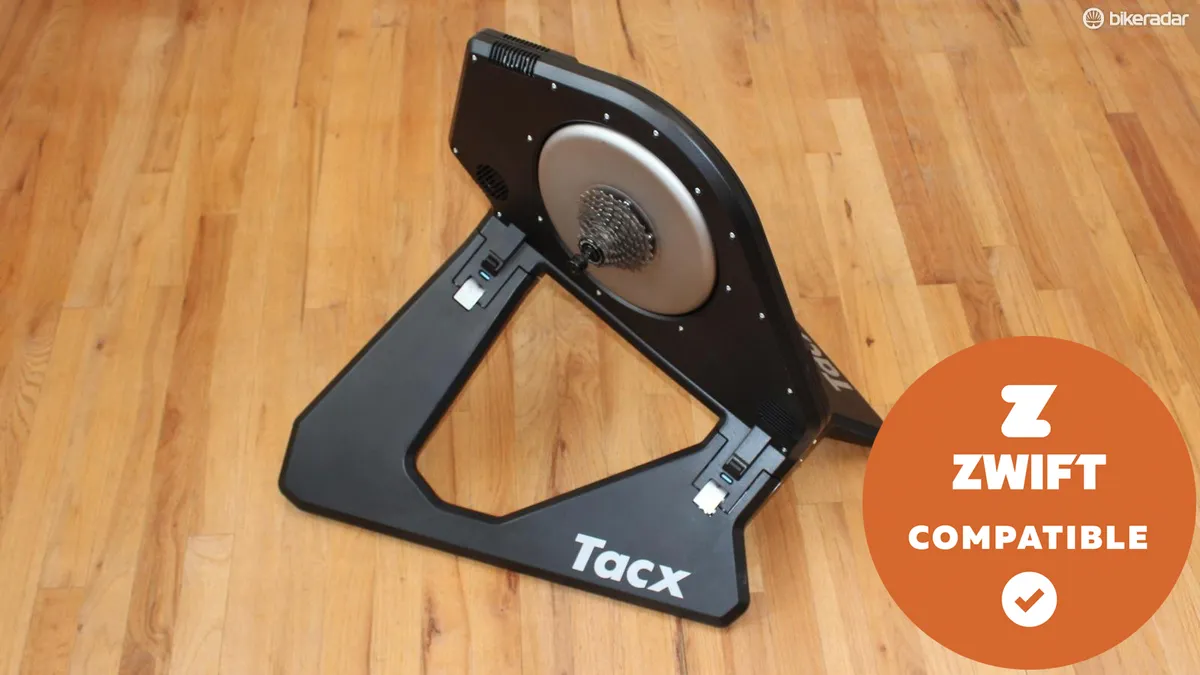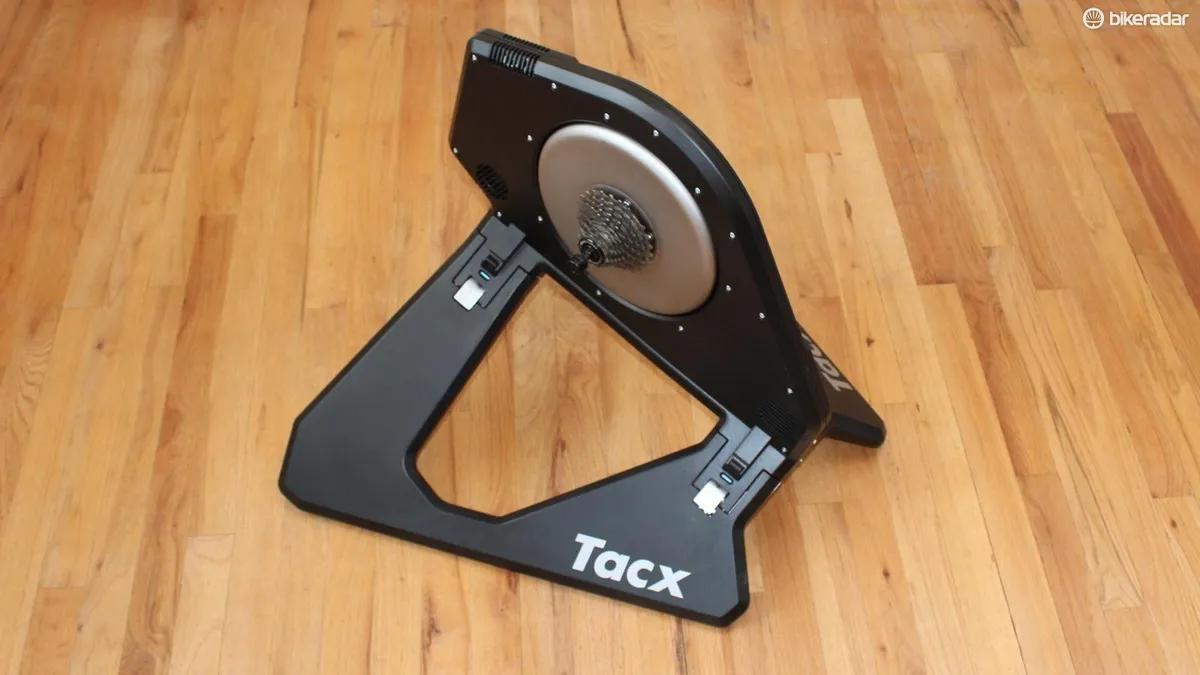Smart trainers are resistance units that wirelessly interact with apps and software to replicate virtual riding conditions and regulate power-based intervals. In this category, the Tacx Neo Smart is in many ways the best there is.
Shaped like Kylo Ren's Command Shuttle from Star Wars, the Neo Power is sturdy, stable and quiet.
Further, the Neo Power has impressively accurate power measurement when tested against pairs of power meters (SRM/Stages, Pioneer/Garmin, Shimano/Garmin) as comparative tools.
But where the Neo really shines is in its ability to mimic some of the sensations of riding outside. Its 'surface treatment' features reproduce the feeling — and, to some extent, the noise — of riding over cobbles, dirt roads, loose boards and more when used with the virtual courses of Zwift. And when coasting down a virtual hill, when you start to pedal again the resistance is minimal, as it is outside, because the Neo's motor engages to help your cassette spin.
Heck, you even get a little laser light show, as LEDs shine underneath the trainer and change color as your effort increases.
So what's the catch? Well, primarily the price.

Tacx Neo features at a glance
- Ride feel: excellent, including boosts on downhills and varied vibrations on surfaces such as dirt, cobbles, wooden bridges, etc.
- Power measurement: excellent consistency but always 5–10w under pedal- and crank-based meters
- Calibration: not an option
- Stability: rock solid stability at base, slight give at axle
- Noise: the quietest of any smart trainer — 70dB at 200w/80rpm; 80dB max
- Portability: fold-up legs, no assembly required, works without plug-in power
- Compatibility: EDCO cassette works with Shimano, SRAM and Campagnolo, but Neo doesn't work with long-cage derailleurs
Tacx Neo set-up and ride impressions
The Neo's legs fold out and spring-lock into place, producing a rock-steady base for riding. There is a bit of give at the rear axle, which initially struck me as odd — and is certainly a departure from the fully rigid construction of the CycleOps Hammer and the Wahoo Kickr — but I came to appreciate the small amount of lateral pivot as more conducive to natural cycling movement.
There is no handle, so moving the 47lb behemoth is challenging. On the plus side, there is zero assembly required, beyond the installation of a cassette on the Shimano/SRAM/Campagnolo-compatible EDCO body (yep, it takes ’em all). Further, you don't even have to plug it in, although running it unplugged robs you of some of the features.
Performance-wise, the Neo is outstanding. While there are magnets to help with resistance, this smart trainer isn't a typical magnetic or electro-magnetic trainer. There is no flywheel. Instead, a motor works with the magnets to act as an electronic brake, offering heaps of resistance and buttery smooth transitions, whether those are instigated by virtual undulations or specific power intervals in a workout.

The brake also provides the Neo's surface treatments, which are created by a varied series of short stutters. As weird as that may sound, it does work to create staccato vibrations at the pedals. (Cycling is weird; we work to eliminate vibrations when on the bike outside, but want to feel them when riding inside.)
The Neo Power also produces up to 450 watts of resistance when pedaling slowly at 6km/h (3.7mph) to simulate incredibly steep climbs — up to a claimed 25-percent grade. Maximum resistance is 2,200 watts. Good luck getting anywhere near that!
Zwift showcases the Neo's strengths. Pedaling on the virtual flats feels like riding actual flats — getting going requires overcoming some initial inertia, but smoothly, just like getting on top of a gear. As your avatar hits a climb, the resistance steadily ramps up. As you crest a hill and begin a descent, suddenly you can shift into a big gear and spin easily along, even coasting and easily getting back on top of the gear.

When used with the excellent training software TrainerRoad, the Neo will doggedly hold the specified power, but will measure some of your natural fluctuations in output. This is a marked difference than the Wahoo Kickr, which will report a pancake-flat power output during controlled intervals (because acceleration has been removed from the algorithm for ERG intervals, effectively smoothing out your reported power).
The Neo isn't silent, but it is one of the quietest smart trainers I have tested, producing 70dB at 200w/80rpm and a maximum of 80dB.
10 of the best smart trainers on the market today
Tacx Neo power comparisons, to meters and other smart trainers
I tested two Neos, one last winter against SRM and Stages meters simultaneously, and another this fall against other pairs of meters: Shimano/Garmin Vector 3, Pioneer/Vector 3, Stages/Vector 3.
Over dozens of rides, the Neo tracked in parallel with the meters, at low, medium and high wattages, and with quick spikes and valleys.
I've tested a dozen smart trainers recently, and while many capture average power of a ride fairly well, they often smooth over fluctuations, or report high at low power and then low at high power.

I found the Neo to measure very dependably in relation to power meters, but always 4–10 watts below what the meters would report. Engineers at Tacx said this is because the Neo measures at the rear hub, and power losses in drivetrain efficiency account for the delta in measurement. I asked Friction Facts founder Jason Smith about this, and he said a 6–8w loss from my Dura-Ace chain with Lilly Lube is reasonable. (Smith's business was founded on measuring drivetrain efficiency.)
Relatedly, the CycleOps Hammer, another direct-drive smart trainer that measures at the hub, reported similarly — always in parallel with meters, but always a little lower. Curiously, though, I found the Wahoo Kickr to track right on top of the meters' numbers.
I believe the Neo's power measurement to be very reliable, and something you could train to with confidence. That certainly isn't the case for a more affordable smart trainer such as the Elite Qubo. If you don't have a power meter, the Neo will serve you well.

Tacx Neo overall
The Tacx Neo and the Wahoo Kickr are the best smart trainers on the market.
The Neo is solid, quiet and smooth in operation. Its unique surface-replication feature adds an engaging element to virtual riding that no other trainer can match.
Compared to pairs of power meters, the wattage measurement is very dependable, just a handful of watts below what crank-, spider- and pedal-based meters read.
If you want the quietest, most engaging virtual smart trainer with power numbers you can train to with confidence, the Tacx Neo is it.







